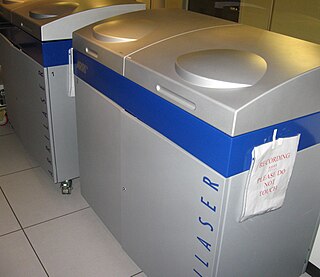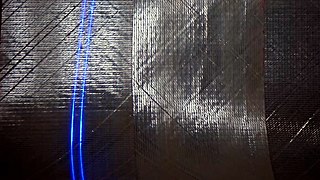
Digital cinema refers to the adoption of digital technology within the film industry to distribute or project motion pictures as opposed to the historical use of reels of motion picture film, such as 35 mm film. Whereas film reels have to be shipped to movie theaters, a digital movie can be distributed to cinemas in a number of ways: over the Internet or dedicated satellite links, or by sending hard drives or optical discs such as Blu-ray discs.

A planetarium is a theatre built primarily for presenting educational and entertaining shows about astronomy and the night sky, or for training in celestial navigation.
IMAX is a proprietary system of high-resolution cameras, film formats, film projectors, and theaters known for having very large screens with a tall aspect ratio and steep stadium seating, with the 1.43:1 ratio format being available only in few selected locations.

A home cinema, also called a home theater or theater room, is a home entertainment audio-visual system that seeks to reproduce a movie theater experience and mood using consumer electronics-grade video and audio equipment and is set up in a room or backyard of a private home. Some studies show that films are rated better and generate more intense emotions when watched in a movie theater, but convenience is a major appeal for home cinemas. In the 1980s, home cinemas typically consisted of a movie pre-recorded on a LaserDisc or VHS tape; a LaserDisc Player or VCR; and a heavy, bulky large-screen cathode-ray tube TV set, although sometimes CRT projectors were used instead. In the 2000s, technological innovations in sound systems, video player equipment, TV screens and video projectors have changed the equipment used in home cinema set-ups and enabled home users to experience a higher-resolution screen image, improved sound quality and components that offer users more options. The development of Internet-based subscription services means that 2020s-era home theatre users do not have to commute to a video rental store as was common in the 1980s and 1990s.

EFILM Digital Laboratories, founded in 1989, is a company serving the motion picture and television industry. Their clients include film studios, independent filmmakers, advertisers, animators, visual effects companies, and large-format filmmakers. EFILM is part of Deluxe Entertainment Services Group, a group of facilities that includes Beast, Company 3, Method Studios, and Rushes.

An LCD projector is a type of video projector for displaying video, images or computer data on a screen or other flat surface. It is a modern equivalent of the slide projector or overhead projector. To display images, LCD projectors typically send light from a metal-halide lamp through a prism or series of dichroic filters that separates light to three polysilicon panels – one each for the red, green and blue components of the video signal. As polarized light passes through the panels, individual pixels can be opened to allow light to pass or closed to block the light. The combination of open and closed pixels can produce a wide range of colors and shades in the projected image.

In color reproduction and colorimetry, a gamut, or color gamut, is a convex set containing the colors that can be accurately represented, i.e. reproduced by an output device or measured by an input device. Devices with a larger gamut can represent more colors. Similarly, gamut may also refer to the colors within a defined color space, which is not linked to a specific device. A trichromatic gamut is often visualized as a color triangle. A less common usage defines gamut as the subset of colors contained within an image, scene or video.

A film recorder is a graphical output device for transferring images to photographic film from a digital source. In a typical film recorder, an image is passed from a host computer to a mechanism to expose film through a variety of methods, historically by direct photography of a high-resolution cathode ray tube (CRT) display. The exposed film can then be developed using conventional developing techniques, and displayed with a slide or motion picture projector. The use of film recorders predates the current use of digital projectors, which eliminate the time and cost involved in the intermediate step of transferring computer images to film stock, instead directly displaying the image signal from a computer. Motion picture film scanners are the opposite of film recorders, copying content from film stock to a computer system. Film recorders can be thought of as modern versions of Kinescopes.

A video projector is an image projector that receives a video signal and projects the corresponding image onto a projection screen using a lens system. Video projectors use a very bright ultra-high-performance lamp, Xenon arc lamp, metal halide lamp, LED or solid state blue, RB, RGB or fiber-optic lasers to provide the illumination required to project the image. Most modern projectors can correct any curves, blurriness and other inconsistencies through manual settings.

Digital light processing (DLP) is a set of chipsets based on optical micro-electro-mechanical technology that uses a digital micromirror device. It was originally developed in 1987 by Larry Hornbeck of Texas Instruments. While the DLP imaging device was invented by Texas Instruments, the first DLP-based projector was introduced by Digital Projection Ltd in 1997. Digital Projection and Texas Instruments were both awarded Emmy Awards in 1998 for the DLP projector technology. DLP is used in a variety of display applications from traditional static displays to interactive displays and also non-traditional embedded applications including medical, security, and industrial uses.

A handheld projector is an image projector in a handheld device. It was developed as a computer display device for compact portable devices such as mobile phones, personal digital assistants, and digital cameras, which have sufficient storage capacity to handle presentation materials but are too small to accommodate a display screen that an audience can see easily. Handheld projectors involve miniaturized hardware, and software that can project digital images onto a nearby viewing surface.
The grating light valve (GLV) is a "micro projection" technology that operates using a dynamically adjustable diffraction grating. It competes with other light valve technologies such as Digital Light Processing (DLP) and liquid crystal on silicon (LCoS) for implementation in video projector devices such as rear-projection televisions. The use of microelectromechanical systems (MEMS) in optical applications, which is known as optical MEMS or micro-opto-electro-mechanical structures (MOEMS), has enabled the possibility to combine the mechanical, electrical, and optical components in tiny-scale.
Fulldome refers to immersive dome-based video display environments. The dome, horizontal or tilted, is filled with real-time (interactive) or pre-rendered (linear) computer animations, live capture images, or composited environments.
Laser color television, or laser color video display, is a type of television that utilizes two or more individually modulated optical (laser) rays of different colors to produce a combined spot that is scanned and projected across the image plane by a polygon-mirror system or less effectively by optoelectronic means to produce a color-television display. The systems work either by scanning the entire picture a dot at a time and modulating the laser directly at high frequency, much like the electron beams in a cathode ray tube, or by optically spreading and then modulating the laser and scanning a line at a time, the line itself being modulated in much the same way as with digital light processing (DLP).

Rear-projection television (RPTV) is a type of large-screen television display technology. Until approximately 2006, most of the relatively affordable consumer large screen TVs up to 100 in (250 cm) used rear-projection technology. A variation is a video projector, using similar technology, which projects onto a screen.

A laser projector is a device that projects changing laser beams on a screen to create a moving image for entertainment or professional use. It consists of a housing that contains lasers, mirrors, galvanometer scanners, and other optical components. A laser projector may contain one laser light source for single-color projection or three sources for RGB full color projection.

A LED display is a flat panel display that uses an array of light-emitting diodes (LEDs) as pixels for a video display. Their brightness allows them to be used outdoors where they are visible in the sun for store signs and billboards. In recent years, they have also become commonly used in destination signs on public transport vehicles, as well as variable-message signs on highways. LED displays are capable of providing general illumination in addition to visual display, as when used for stage lighting or other decorative purposes. LED displays can offer higher contrast ratios than a projector and are thus an alternative to traditional projection screens, and they can be used for large, uninterrupted video walls. microLED displays are LED displays with smaller LEDs, which poses significant development challenges.
An electronic visual display is a display device that can display images, video, or text that is transmitted electronically. Electronic visual displays include television sets, computer monitors, and digital signage. They are ubiquitous in mobile computing applications like tablet computers, smartphones, and information appliances. Many electronic visual displays are informally referred to as screens.

MicroTiles are discontinued modular rear projection cube units designed, developed and marketed by Christie Digital. The building-block nature of the system made the configuration of the overall screen area and shape flexible. This allowed for simple traditional rectangular displays, and more complex non-standard shapes.

DCI-P3 is a color space defined in 2005 as part of the Digital Cinema Initiative, for use in theatrical digital motion picture distribution (DCDM). Display P3 is a variant developed by Apple Inc. for wide-gamut displays.
















